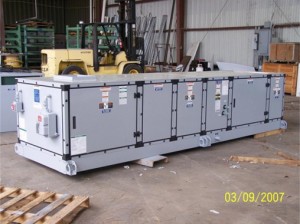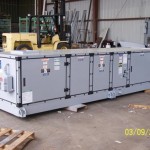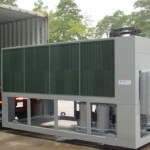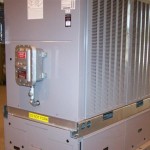Explosion Proof HVAC
Tisdale Company can design and build HVAC/R systems from the ground up or modify customer preferred equipment for hazardous locations on shore or off shore. Tisdale Company has extensive knowledge of the industry standards required for explosion proofing air conditioning equipment by meeting or exceeding all of the latest codes found in NFPA (NEC)
What type of protection is required?
To determine what type of protection is required on HVAC equipment we must first look at the application. National Electric Code (NEC®) which is a part of The National Fire Protection Association (NFPA) or also known as NFPA 70 and ANSI/NFPA 70 has definitions for all the types of protection that is used in hazardous or classified locations such as:
Explosion Proof

Electrical equipment housed in an enclosure that is capable of withstanding an explosion of a specified gas or vapor that may occur within it and of preventing the ignition of a specified gas or vapor surrounding the enclosure by sparks, flashes, or explosion of the gas or vapor within and that operates at such an external temperature that a surrounding flammable atmosphere will not be ignited thereby.
Dust Ignition Proof
Electrical equipment enclosed in a manner that excludes dusts and does not permit arcs, sparks, or heat otherwise generated or liberated inside of the enclosure to cause ignition of exterior accumulations or atmospheric suspensions of a specified dust on or in the vicinity of the enclosure.
Dust Tight
Enclosures constructed so that the dust will not enter under specified test conditions.
Purged and/or Pressurized
Purged is the process of supplying an enclosure with a protective gas at a sufficient flow and positive pressure to reduce the concentration of any flammable gas or vapor initially present to an acceptable level. Pressurized is the protected enclosure shall be constantly maintained at a positive pressure of at least 0.1 in. of water above the surrounding atmosphere during operation of the protected equipment.
Intrinsically Safe
This protection technique shall be permitted for equipment in Class I, Division 1 or 2; or Class II, Division 1 or 2; or Class III, Division 1 or 2 locations.
These definitions set the criteria that must be met by all components installed in hazardous (classified) locations.
Temperature Rating

The maximum surface temperature of the exposed surface of electrical apparatus must always be lower than the ignition temperature of the gas or vapor mixture. Temperature classes are: T1, T2, T3, T4, T5, and T6. Equipment that does not exceed a maximum surface temperature of 212°F(104°F ambient temperature) is not required to be marked with a temperature code (NEC).

Understanding the class, division and groups of hazardous (classified) locations
Class – Nature of hazardous substance that is present and broken down into three categories:
- Class I – Potentially explosive gas or vapor
- Class II – Potentially explosive dust
- Class III – Potentially explosive fiber
Division – Frequency of presence is broken down into two categories:
- Division 1 – Potentially explosive substance present under normal operating conditions.
- Division 2 – Potentially explosive substance present under abnormal operating conditions.
Group – Specific type of hazardous material which is broken down into seven types of atmospheres:
Group A, Group B, Group C, Group D, Group E, Group F, Group G and each of the groups have a list of the type of gases, vapors and dust that pertain to each type of group.
To help identify some hazardous-locations installations, here is a few typical listing of some locations where hazardous conditions are expected to exist.
Class I Industries and Applications:
- Natural or liquefied gas storage facilities
- Chemical plants
- Petroleum refineries
- Bulk handling or storage facilities for gasoline
- Dip tanks
- Storage tanks for flammable liquids or gas
- Spraying areas for paints or plastics
- Aircraft fuel servicing areas or hangers
- Well drilling (oil and/or gas), offshore and onshore
- Pipeline pumping stations
- Printing machine areas
- Gasoline service stations
Class II Industries and Applications:
- Grain storage, handling or processing plants
- Coal storage, handling or processing facilities
- Metal grinding or metal power producing plants
- Gunpowder or explosive (fireworks) plants
- Sugar, cocoa, spice or starch production or handling facilities
Class III Industries and Applications:
- Cotton, textile or flax producing or handling facilities
- Wood cutting, pulverizing or shaping plants
- Clothing manufacturing facilities


















